
Best Mobile Phones For The Elderly
From its origins as a bulky and somewhat unreliable status symbol for the wealthy business person, the mobile phone has emerged as an essential part of modern living.And part of this emergence, no doubt, is due to the staggering increase in functionality and features over time. In fact, it is probably easier to list the things you can’t do on today’s mobile phones than vice versa!For many, this is ideal. They want as many features crammed into their mobile device as possible, sparing no expense when it comes to purchasing the latest flagship model.For others, though, it has all become a bit overwhelming. And if you are an elderly person who has yet to dip their toe into the ever widening pool of cellular options, it can be a nightmare just figuring out where to begin.That’s why we’ve put together this list of the best mobile phones for the elderly. Some have made the cut due to their ease of use, others because they were designed specifically with the elderly in mind.Note: Whilst some of the options below feature an ‘SOS’ button, you should not consider replacing a monitored personal alarm with a mobile phone. The SOS button on a mobile is used to call selected contacts only, meaning help is entirely reliant on the availability of these contacts. A monitored personal alarm (such as the YourStride alarm watch) will connect you to a 24/7 emergency help team who have the experience and expertise to get you the help you need. For more information on the YourStride personal alarm, please click here.
The Best Mobile Phones For The Elderly
Doro 7080
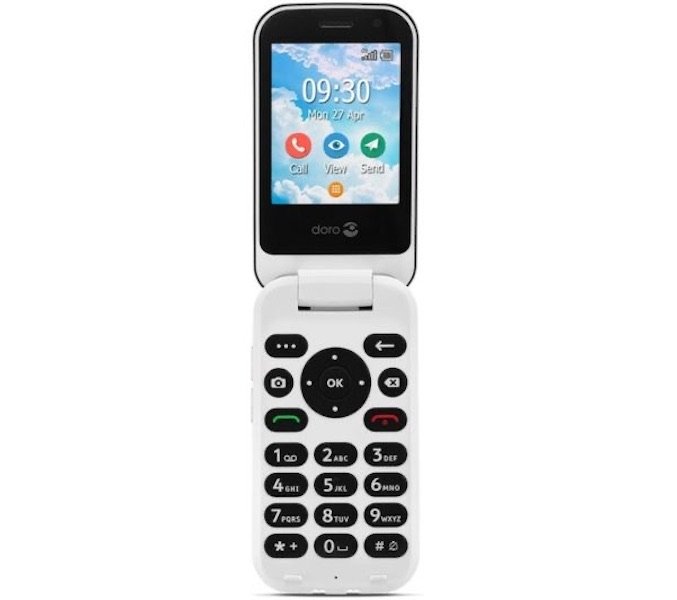
The Doro 7080 is a large screen flip-phone with an external display (so that you can see who is calling you without flipping open the device). Designed with the elderly in mind, the keys have ample separation, the sound is loud and clear, and there’s even an emergency response button which puts you in contact with your loved ones immediately should the need arise.When the emergency response button is activated, your loved one will receive a call with a distinct tone, and their phone will ring even if set to ‘silent’. Whilst not as reliable as an alarm which contacts a dedicated monitoring centre, Doro have taken some great steps to ensure that emergency calls are answered as frequently as possible.Whilst remaining simple to use, the Doro 7080 also features a camera, and apps such as whatsapp and facebook - so it’s a perfect starter phone if you’d like a device that does more than just the bare essentials.
Alcatel 10.66G
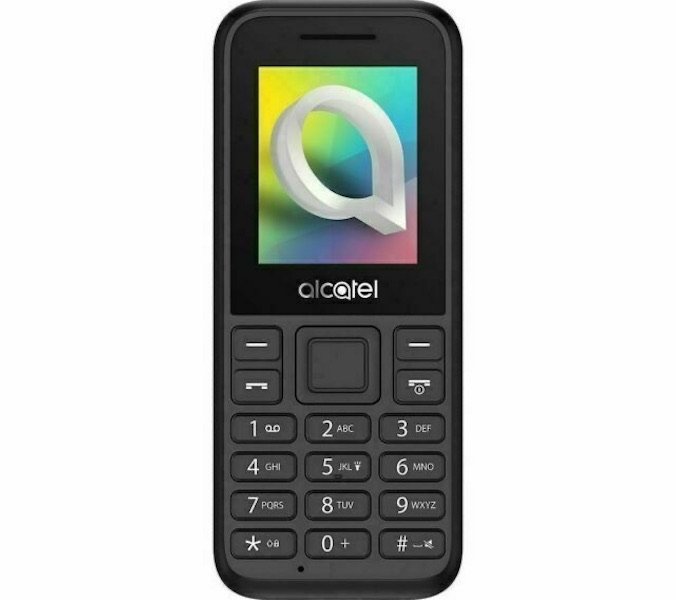
The Alcatel 10.66G is a discreet and easy to use mobile phone. Despite its relatively small size, the button keys are large enough that most should have no problem using the device.It features a camera, as well as basic tools such as a calendar, torchlight, converter and an app for jotting down notes. Unlike the Doro, there is no emergency response button, nor is there support for the latest and flashiest mobile applications. Whilst this will turn some off the idea of this phone, it may appeal to those who want a simple and easy to use device that does the job and is clutter free.
Nokia 105
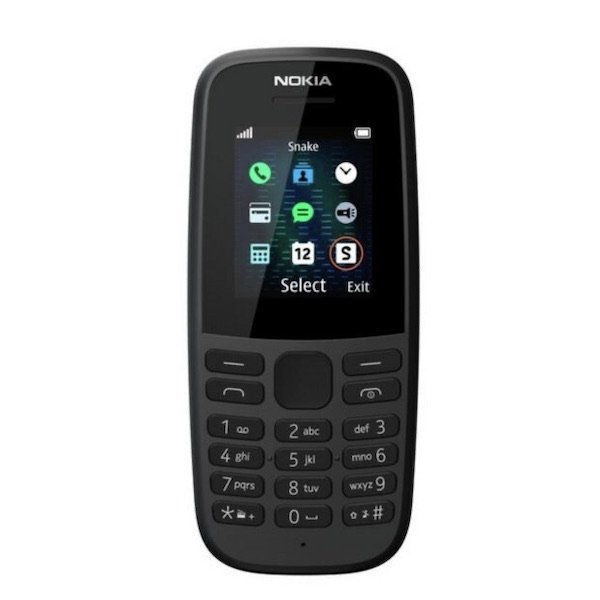
This little Nokia phone prides itself on its long battery life. In fact, you get around 10 hours of continuous chatting time before a recharge is required. And if you’re not using the phone, that battery life just seems to go and on.A long battery life is particularly handy given that you can add up-to 2000 saved numbers to the device, so this phone is definitely a front runner for the more popular amongst us! And as well as that, you’ll also be able to store 500 messages, sparing you the arduous task of clearing up space on the device regularly.Outside of that, the Nokia 105 has a sleek, modern design, an FM radio, and even the odd game to enjoy.
Alcatel 2057D
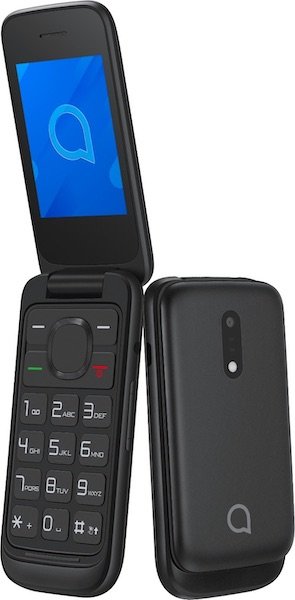
The second appearance by Alcatel in the list, the 2057D is an easy to use flip-phone for the elderly. The 2.4inch display should make reading the screen a doddle, and this is partnered with a large and spacious keypad.The battery life is impressive (though not quite as long as the Nokia 105), with up to 6 hours talk time, and over 200 hours in standby mode. The phone features a camera, basic tools (calendar, bluetooth, and so on), and the ability to increase storage via an SD card which could be very handy for those who love to take photos and videos. You’ll have to purchase the SD card separately, and then it’s just a case of plugging it into the port on the phone.
Artfone C1
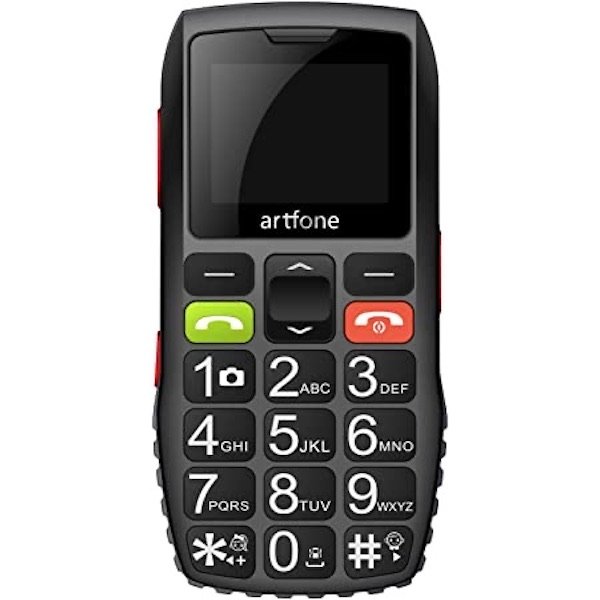
The first thing you’ll notice when looking at the Artfone C1 is its unique design. The ridged sides are designed to absorb impact in the case of a fall. The red button on the back is used to make emergency calls to friends and loved ones. You can add up to 5 emergency contacts, and pressing the red button will cycle through these contacts until your call is answered. On top of that, each of your contacts will also receive a text message once the SOS button is pressed.This is a sturdy, big-button mobile phone that is perfect for the elderly. Its proprietary operating system features a large font and is designed to be as accessible as possible for all. The built-in speaker is loud and clear, the battery life is long (5-6 hours of continuous talk time), and there’s some handy built-in features such as bluetooth, FM radio, alarm clock, calendar and more.
Easyphone Smart 1
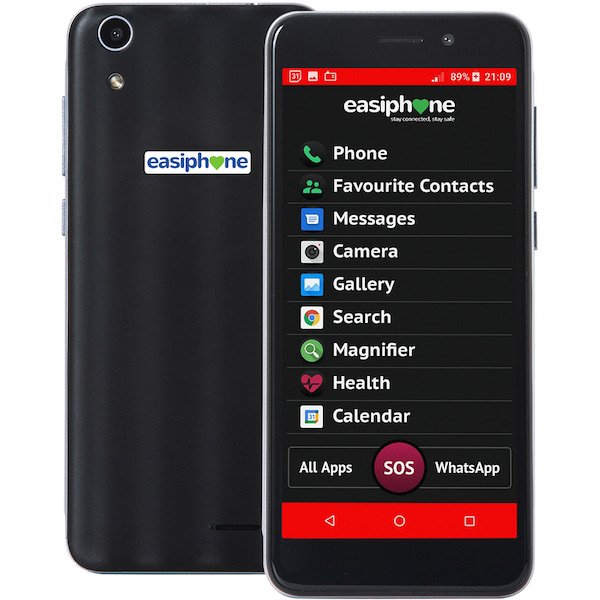
Like the Artfone C1 above, this phone features some handy safety features for the elderly. There’s an SOS button that when pressed shares your location with up to 6 emergency contacts (you’ll have to add these in beforehand). Beyond that, the device also features an app which can be linked to the NHS, offering pill and appointment reminders.For those who struggle with their sight, you’ll be pleasantly surprised to find a magnifier app, as well as the option to switch the display between icons and text. It comes with whatsapp and other useful apps pre-installed, a nice built-in camera, and the ability to search the web at the click of a button.
Doro 8050
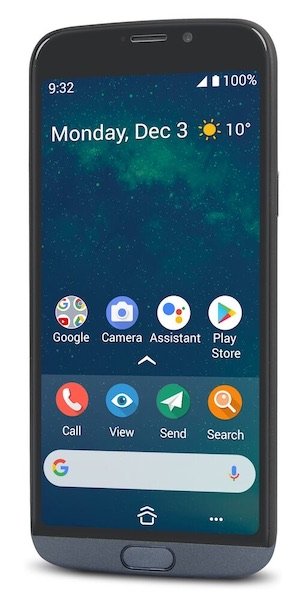
Like the previous Doro in the list, this is an easy to use mobile phone designed with the elderly in mind. The Doro 8050 is a large screen smartphone featuring google assistant (so you can input commands using your voice), a great camera, an easy to use interface and an emergency response button. As with other Doro devices, pressing this button will alert your emergency contacts so that they can provide assistance when required.Beyond those handy features, this phone runs on a modern version of the android operating system so it should work with the most popular apps available today. It features a loud and clear speaker, and an excellent, high quality screen that should help those with visual impairments. Oh, and for the clumsy amongst us, the Doro 8050 is built with durability in mind so should survive all but the most disastrous of fumbles!
iPhone SE 2020
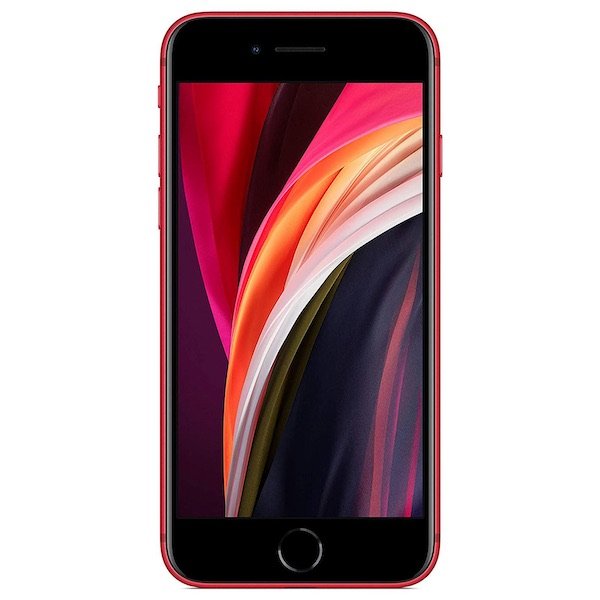
A bit of an outlier on this list, the iPhone SE 2020 is an industry leading device with all the features anyone, regardless of age, would want. What sets it apart from others, however, is just how simple it is to use.It also helps, of course, that you’re likely to know someone who owns an iPhone, so an in-person tutorial is never too far away. And failing that, this phone has so many users that there is an abundance of manuals, tips and how-to-use guides available online.The iPhone SE 2020 offers the very best in modern phone tech, and whilst this abundance of functionality may seem a little daunting, it has all been designed with ease of use in mind. If you’re looking for a modern phone with all the best features then this may be the best option. If however you’re likely to use your phone for the basics only, there’s better options (not least in terms of value for money) elsewhere in this list.
Mobile Phones For The Elderly Guide
As an elderly person, what are the benefits of owning a mobile phone?
Emergency Help
Having a mobile phone means that, should an emergency arise, you’ll probably be able to reach out and get help. We say ‘probably’, as this will depend on your phone signal, battery level, and whether or not your contact is available to take your call. Whilst mobile phones are not replacements for personal alarms (particularly those with a dedicated emergency monitoring centre), they may be a life-saver in certain situations - particularly for those who don’t carry a personal alarm with them regularly.
Keeping In Touch
Humans are social animals, and a mobile phone makes it incredibly easy to keep in contact with those you love. Depending on the device, you can call, text, email, and even make video calls. If you regularly use your landline to stay in contact with those you care about, a mobile phone could also save you money depending on which contract and network carrier you opt for.
Fun!
There’s a reason most kids are glued to their phones - they are fun! Whether it be taking funny photos, watching the latest ‘viral’ video or simply browsing your favourite website, you’re bound to find a way to enjoy yourself on your phone. New apps are released everyday, covering everything from crossword puzzles to foreign language tutorials, so you’ll always have something new to check out.
All-in-one toolkit
Even the most basic mobile phones include an alarm clock, calendar, calculator, and notepad. Having all these essential tools at your fingertips is extremely handy, and you can keep adding to this toolkit by downloading your favourite apps (providing your phone supports them). Making the transition to a digital toolkit might seem a little daunting, but once you’ve mastered the basics (and you will, quickly) you’ll never look back.
Reminders
If you find yourself forgetting things regularly, then a mobile phone can help by alerting you with pre-set reminders. These can be saved as daily reminders (for instance, when to take your pills), or used in a more ad-hoc fashion (i.e, get the food out of the oven in 20 mins!). If your phone features a voice assistant, then you can actually ask it to set a reminder without touching the device at all.
What should I look for when choosing the best mobile phone for the elderly?
SOS button
Some mobile phones have an emergency button that, when pressed, will notify your chosen contacts that help is required. How it goes about getting you help varies from device to device. Some will call your first contact, and if there is no answer, move on to the next contact, and so on. Some will call one contact and that will be that. Others will instead send a message to all emergency contacts. It’s important to understand exactly how this works prior to purchasing your phone.Remember, a mobile phone is never going to be quite as good as a dedicated personal alarm, so it’s important to keep hold of your alarm irrespective of which phone you purchase.
Button size
As we age, our fingers become a little less nimble, so larger buttons are handy in a mobile phone for the elderly. Larger buttons also allow more space for descriptive text and/or digits, so will help those with visual impairments.As well as looking out for button size, you should also take into account the spacing between buttons when choosing a mobile phone for the elderly. If the buttons are a little too crammed, it might be difficult for some to reliably push the button of choice.
Screen Size
As with larger buttons, a larger screen will make it easier to read information. If you have a smartphone, you can typically zoom into any area of the screen with some simple finger motions. Most phones will also allow you to increase the size of the default fonts, and a larger screen will ensure that you can still access a decent amount of text without having to scroll.
Voice Assistant
Some mobiles feature a voice assistant, allowing you to communicate with the device through speech. You could ask it to set a reminder, call a relative, or even read you the latest news! For those with visual impairments or difficulty dealing with the small buttons, this might be an ideal workaround. Some phones are also able to translate text to speech with great accuracy, which is bound to save time for those frequently found searching endlessly for the right letter when typing a message.
Volume
It’s no secret, as we age our hearing tends to get a little worse. That’s why it’s important to consider the volume when choosing a mobile phone for the elderly. You’ll want to check the ring volume, as well as the volume during conversations. For those with a hearing aid, you should be looking for hearing aid compatible (HAC) phones.
Operating System
The operating system is the brains behind your mobile phone. It governs how everything works, and what steps you need to take in order to access the various functions of your phone. That includes making a call, using the camera, or playing the latest game.Given its importance, you’ll be unsurprised to find that some manufacturers have created operating systems with the elderly in mind. These tend to have more accessibility features (magnifying glass, voice readers, etc) and are simpler to use overall. If this is your first mobile phone, we would recommend going with an operating system designed specifically for the elderly.
Should I get a contract or use Pay As You Go (PAYG)?
Once you decide on which mobile phone you would like to own, you need to make a decision on how you wish to pay for it going forward. Whilst your initial investment is for the device itself, the cost going forward will be used to cover your calls, texts and internet usage (if applicable). We detail the two plans below:
Pay As You Go (PAYG)
As the name suggests, with Pay As You Go you pay based on usage. This usually involves ‘topping up’ the phone with credit, which will the be used when data (calls, texts, internet) is utilised. If you plan on using your phone infrequently, this might be the best option as your credit is only reduced when data is used.With that said, PAYG tends to have higher rates for data than contracts, so this type of plan may cost you more money in the long run. If you already own a phone on a PAYG plan and find yourself topping up regularly, it may be worth switching to a contract.
Contract
A contract is typically the best option if you use your phone a lot, though it’s important to choose a contract which works for your criteria. Most contracts have a quota of minutes, texts and internet data that you can use. Going above this quote will typically result in over-use charges, so it’s a good idea to estimate how many minutes, texts, or internet data you’ll potentially be using before opting for a contract.Once you have a figure in mind, opt for a contract with quota that exceeds this slightly to avoid any unwanted surprises. If you want complete peace of mind, you could go for a contract which offers unlimited minutes and texts. Whilst an unlimited contract is typically the priciest option, these have fallen in cost over recent years and may be worth it for you.If your phone has an emergency button, we would recommend a contract. The last thing you want is to find yourself in an emergency but without the credit required to make the SOS call.
Can a mobile phone replace a personal alarm?
A mobile phone, even when featuring an SOS button, is not a replacement for a dedicated personal alarm. The YourStride alarm watch, for instance, is monitored 24/7 by an experienced team who are always ready to get you help. There is no guarantee that the emergency contacts on your phone will be available to come to your aid, and it is unlikely that they will have the experience required to deal with the situation as efficiently as a trained professional.It’s also worth bearing in mind that your mobile signal is tied to your specific network carrier's reception in any given area. The YourStride alarm avoids this issue by automatically connecting to the strongest network signal in any area. This ensures that connection blackspots are at a bare minimum.The YourStride alarm watch works anywhere in the UK, 24/7. We have an experienced monitoring team available at the touch of a button to get you the help you need. If you're looking for more information on the YourStride alarm, you'll find all the information you need on our personal alarm and fall alarm pages.